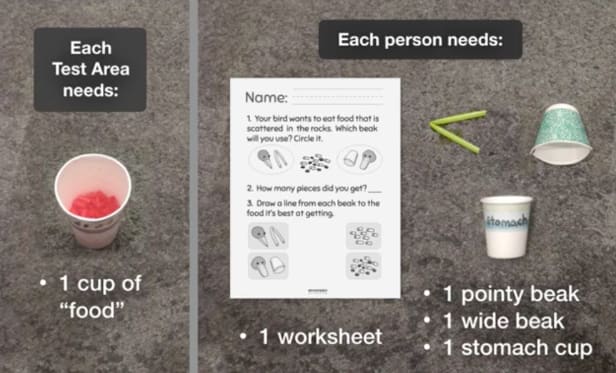




DISCUSS: How are these beaks different?
















There are several ways to extend this activity.
Epic! offers books online for teachers to use for free. Just click “Get Started” to register.
Quack Like A Duck — a fun book that will have kids mooing, quacking, and hee-haw-ing. (for ages 0 to 4)
Animals on the Farm: Ducks — A duck on the farm describes his life. (for ages 5 to 7)
I Love You Just Enough — A girl raises a lost duckling, then lets it return to nature as a wild duck. (for ages 7 to 9)
Watch videos of different birds eating. After each video, talk about what the bird is eating and how it uses its beak.
Do you think a hummingbird could crack a nut like a macaw? Do you think a macaw could catch a fish like a great blue heron?
A bird’s beak is like a tool that helps the bird eat. What kinds of tools would you use if you wanted to:
Can you think of a bird beak that works like these tools?
If you’re stumped, advance to the next slide to see our ideas.
At Mystery Science, we use nutcrackers for cracking nuts. A parrot’s beak is short and strong, and it works like a nut cracker.
A spoon is good for scooping up soggy cereal. It works like a duck’s broad bill.
A straw helps you sip soda from the bottom of a tall glass, just like the hummingbird’s beak lets that bird sip the sweet juice called nectar from the bottom of a flower.
A fork can stab a slippery fish, just like the pointy beak of an egret.
Grade 1
Plant & Animal Structures And Survival
Animal Structures & Survival
1-LS1-1
In this lesson, students carry out an investigation to determine the relationship between the shape of different bird beaks and the food each bird eats. In the activity, Find the Best Beak, students experiment with long pointy beaks that are great for picking up seeds and wide flat beaks that are good for scooping. They discover that different beaks are best for different kinds of food.
Preview activity| Bird Beaks worksheet | 30 copies |
|
Black Beans (Dried)
Any dried beans will work. If you must avoid food, substitute large beads.
|
Details
2 pounds
|
|
Dixie Cups (3 oz)
Each student will need 2 cups. We suggest having a few extras on-hand.
|
Details
60 cups
|
|
Elbow Macaroni
If you must avoid food, substitute straws cut into pieces that are about ½” long.
|
Details
2 pounds
|
|
Masking Tape
|
96 feet |
|
Paper Cups (8 oz)
|
16 cups |
|
Plastic Straws (Not Bendable)
Each student needs 1 straw. We suggest having a few extras on-hand.
|
Details
30 straws
|
We suggest students work in groups of four. Homeschool students can work on their own.
This activity works best on a low pile carpet. If your classroom has a smooth floor (such as linoleum), you’ll need a bath towel to serve as the work area for each group of 4 students.
Each student will need a “pointy beak” and a “duck beak” to experiment with.
Here’s how to make a “pointy beak”:
Here’s how to make a “duck beak”:
Mark off a test area for each group of four students.
For each group, you’ll need to prepare two cups. One filled with model “bird food” and the other filled with model “rocks.”
At the start of the activity, each student needs a worksheet, “pointy beak,” “duck beak,” and “stomach cup.” Each group also needs a cup of “bird food.”

Each group will need a cup of “rocks” later in the activity. You may want to organize or separate supplies for easier classroom distribution.
Grade 1
Plant & Animal Structures And Survival
Animal Structures & Survival
1-LS1-1
Thanks for your feedback! If you have a question or need help, please contact us. Please consider sharing your review:
Sorry the lesson didn’t go well. We read every single review in an effort to improve our Mysteries.
Thanks for letting us know. We’ll wait to ask you for feedback until after you've actually taught it.
Thanks for the feedback! We read every single review in an effort to improve our Mysteries.
Please follow these steps:
Locked
6:10

Why is the sky blue?
Locked
4:41

Why do we call them doughnuts?
Locked
5:16

Could a turtle live outside its shell?
Your membership is expired. The archive of past Mini Lessons is not included in your limited access.
View pricing